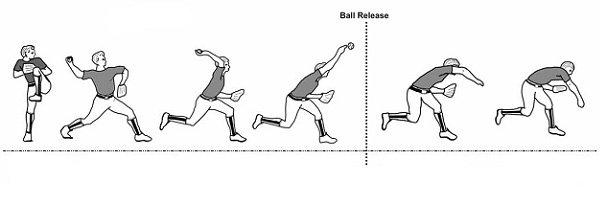Phase 1 Pitching, The Windup:
Muscle activity in the shoulder is generally inactive, due to the subject lifting the lead leg in preparation to release the ball. This is the position of correct posture and balancing.
Phase 2 Pitching, Early Cocking:
During this motion the deltoid muscle is the primary mover, followed by the rotator cuff muscles which are secondary, as the arm elevates in forward flexion and abduction. The energy that’s generated comes from the rotational loading and coiling of the lower body. Muscles including the paraspinals, abdominals and glutes are commonly activated, although with weakness of the trunk muscles, this generally leads to an increased lumbar lordosis causing the shoulder and arm to follow behind during the throwing motion. Maintaining trunk muscle strength is key throughout the early cocking phase.
Phase 3 Pitching, Late Cocking:
Phase 3 begins with the lead foot making contact with the ground as well as the shoulder being abducted to 90o, horizontal extension of 30o and subsequently reaching 160o – 180o external rotation. The main muscles activated are the rotator cuff muscles rather than the deltoids. The supraspinatus muscle is isometrically contracting to maintain humeral head stabilisation and the infraspinatus and Teres minor muscles are concentrically contracting as the subscapularis is eccentrically contracting to decelerate the external rotation and protect the anterior shoulder joint. The serratus anterior provides a secure platform for the humerus during this phase and the latissimus dorsi prevents anterior subluxation of the humeral head, meaning these two muscles are also extremely important to strengthen during this stage. Sub acromial impingement may result with lesions commonly tending towards anterior subluxation due to repetitive stresses to the anterior capsule and inferior Glenohumeral ligament complex.
Phase 4 Pitching, Acceleration:
This pithing phase involves releasing the ball at about 100o of external rotation. The prime movers including the pectoralis major, latissimus dorsi, triceps and subscapularis are concentrically contracted while the rotator cuff muscles are kept relatively quiet. The acceleration during this phase is caused by the forward momentum and weight transfer from the trunk to the arm and the internal rotators as mentioned above. The trapezius, serratus anterior, rhomboids and levator scapula also help to stabilise and position the scapula. It was also found that professional baseball pitchers utilise the subscapularis muscle to direct humeral rotation, while amateur pitchers activated the other rotator cuff muscles and the biceps brachii for power in a comparison between the two. Professional pitchers also utilised the pectoralis major, serratus anterior and the latissimus dorsi more efficiently than amateurs.
Phase 5 Pitching, Follow-Through (Deceleration)
The deceleration and final stage of the pitchers arc of motion involves utilising the posterior shoulder muscles of the Teres minor, the biceps, the scapular muscles, the serratus anterior, rhomboids and the middle and posterior deltoids. These muscles all combine in the movement of resisting humeral distraction and decelerating the extremity. Pathomechanics from arm deceleration:
- Subacromial impingement- due to the flexed, horizontally orientated adducted and internally rotated arm causes a superior translation of the humeral head
- Tensile posterior injuries to the Teres minor, infraspinatus and posterior deltoid muscles ( rotator cuff muscles of shoulder)
- Anterior subtle or excessive laxity causes impingement on the anterior labrum
- Grinding of anterior labrum due to a failure in the compressive force needed throughout the deceleration phase in order to prevent any abnormal humeral translation.
- Increased stresses on the bicep due to SLAP lesions when the elbow is extended at a rate to fast for the body to handle.
- Decreased pain threshold upon the follow through may be due to a scapulothoracic bursitis at the inferior medial angle of the scapula.

Lakeside Chiropractic is located in Joondalup, central to Perth’s northern suburbs. We have visitors from many suburbs around Perth including, Wanneroo, Ashby, Mullaloo, Jindalee, Alkimos, Hilary’s, Woodvale, Heathridge and Wembley Downs. HICAPS facilities are available onsite for all major health insurance providers (NIB, HBF, NCF, HCF, AHM), medibank preferred practitioner and also a part of the BUPA Members first Network. If you were interested in gathering more information or book an appointment you can give us a phone call on 9300 0095 or visit our website www.lakesidechiro.com.au, we look forward to seeing you shortly.



